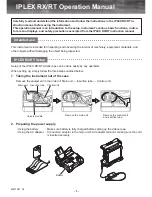
MEASUREMENTS
7
6. MEASUREMENTS
Make sure the meter has been calibrated and the
protective cap has been removed.
Immerse the tip of the probe in the sample to be
tested while ensuring that also the temperature
sensor is immersed.
For accurate dissolved oxygen measurements, a water movement
of at least 0.3 m/sec is required. This is to ensure that the
oxygen-depleted membrane surface is constantly replenished.
A moving stream will provide an adequate circulation. To quickly
check if the water speed is sufficient, wait for the reading to
stabilize and then move the D.O. probe. If the reading remains
stable, the measurement conditions are right, while if the reading
increases the water movement is not adequate.
During field measurements, this condition may be met by manually
agitating the probe. Accurate readings are not possible while the
liquid is at rest.
During laboratory measurements, the use of a magnetic stirrer to
ensure a certain velocity in the fluid is recommended.
In this way, errors due to the diffusion of the oxygen present in the
air in the solution are reduced to a minimum.
Anyway, wait the time necessary for thermal equilibrium to occur
between the probe and the sample (a few minutes for temperature
difference of several degrees).
The meter can display D.O. readings in mg/L (ppm) and in % O
2
(rate of Oxygen saturation with reference to 100% at sea level).
Press the RANGE key to select the desired range.
The temperature measurement is always displayed on the lower
part of the LCD.
If the sample contains salts or if the measurement is performed
at altitude different from sea level, the readout values must be
corrected, taking into account the lower degree of oxygen solubility.
Set altitude and salinity compensations before performing calibration
and taking measurements. The meter will automatically compensate
for these factors.


































